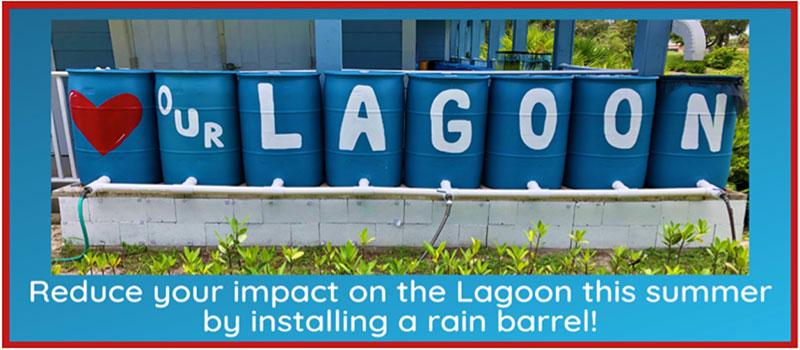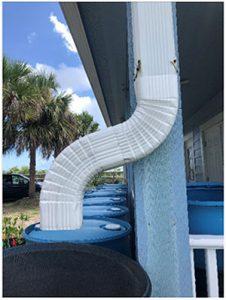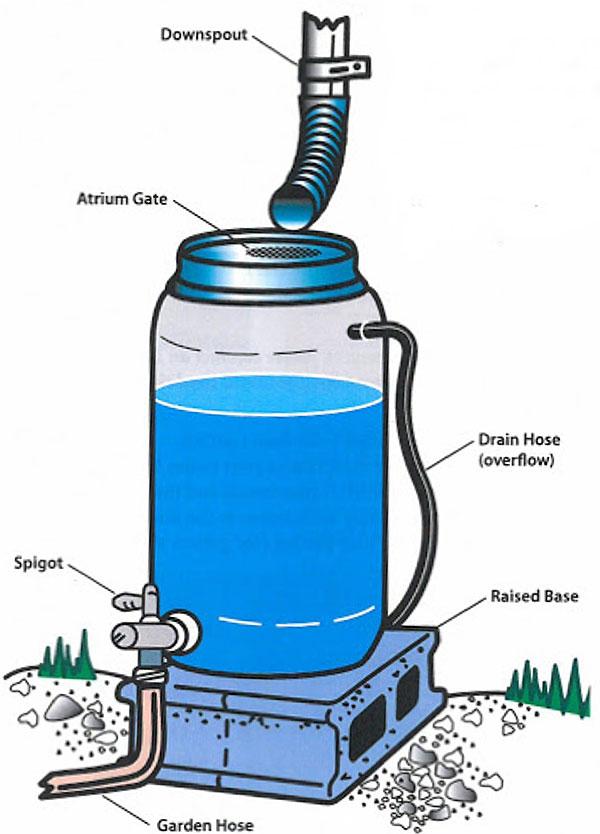Rain Barrels Rock!
 Over the last 50 years, development in Florida has skyrocketed and our ecosystems have changed as a result. One of the most obvious changes we have caused is the abundance of stormwater runoff that now enters our waterways. Stormwater runoff is the excess water from rain events that does not absorb into the ground. The amount of stormwater is exacerbated due to the presence of impermeable surfaces, such as streets, parking lots, and residential and commercial rooftops. As stormwater flows over these surfaces, it captures debris, litter, animal waste, and fertilizers that are deposited in our waterways. These pollutants can greatly increase the abundance of nutrients that cause algae blooms.
Over the last 50 years, development in Florida has skyrocketed and our ecosystems have changed as a result. One of the most obvious changes we have caused is the abundance of stormwater runoff that now enters our waterways. Stormwater runoff is the excess water from rain events that does not absorb into the ground. The amount of stormwater is exacerbated due to the presence of impermeable surfaces, such as streets, parking lots, and residential and commercial rooftops. As stormwater flows over these surfaces, it captures debris, litter, animal waste, and fertilizers that are deposited in our waterways. These pollutants can greatly increase the abundance of nutrients that cause algae blooms.
 One of the simplest and easiest ways to reduce your impact on stormwater pollution is to install a rain barrel (or several!) at your home or business. Rain barrels capture the runoff produced by your roof and store the water for future use. A home in the City of Melbourne in Brevard County with a 40’ by 80’ roof has over 100,000 gallons of rain water runoff each year! In the month of April, which has the lowest average rainfall for the Melbourne area at 2.1 inches, a 9 foot x 10 foot roof will produce 4,189 gallons of runoff or approximately seventy-six 55-gallon rain barrels! That’s a lot of water!
One of the simplest and easiest ways to reduce your impact on stormwater pollution is to install a rain barrel (or several!) at your home or business. Rain barrels capture the runoff produced by your roof and store the water for future use. A home in the City of Melbourne in Brevard County with a 40’ by 80’ roof has over 100,000 gallons of rain water runoff each year! In the month of April, which has the lowest average rainfall for the Melbourne area at 2.1 inches, a 9 foot x 10 foot roof will produce 4,189 gallons of runoff or approximately seventy-six 55-gallon rain barrels! That’s a lot of water!
This is free, clean rain water that can be used to water ornamental plants, gardens, and lawns—and can even be used to fill your pool or wash your car! This will reduce your use on municipal sources and will save you money. Rain barrels are easy to install and maintain; just check out the steps below. If you live in Brevard County and are ready to purchase your own rain barrel, visit the MRC website https://lovetheirl.org/education/rain-barrels/ or call at 321-725-7775!
Installation
 Step 1: Before you install your rain barrel, it is important to ask yourself a few questions.
Step 1: Before you install your rain barrel, it is important to ask yourself a few questions.
1. Is the location I want to put the barrel easily accessible?
a. If you are not able to easily access your barrel or the water from it, it is unlikely that you will realistically use your rain barrel after the novelty wears off.
2. How much sun does this area receive?
a. It is best to put your barrel in a location that does not receive an abundance of direct sunlight. This is because sunlight will cause the water in your barrel to heat, promote algae growth, and potentially harm your plants.
3. Does this location accumulate roof runoff?
a. Your barrel should be placed at a location that produces the greatest amount of roof runoff for the greatest reduction in stormwater runoff. This is usually the location of one of your downspouts or from a “V” or corner of your roof.
Step 2: Raise the Barrel
Once you have selected your location, your rain barrel must be set on a solid, raised platform. This can be as simple as cinderblocks and paving tiles. We recommend using four paving tiles laid in a square with two layers of cinder blocks placed on top and capped with four more paving tiles — like a paving tile sandwich! The height will improve water pressure and will enable you to place a watering can beneath the rain barrel spigot.
 Step 3: Adjust the Downspout (if needed)
Step 3: Adjust the Downspout (if needed)
After you have raised your barrel, you may need to adjust your downspout so that the rainwater will flow directly into the barrel. Do this by cutting the spout with a hacksaw or tin snips. You can choose to leave the downspout as is, or you can attach an adjustable/flexible downspout. If you are using the attachment, secure it with metal screws or zip ties.
Step 4: Downspout Diverter or Overflow
This step will depend on your location of the barrel and how often you plan on using your barrel. Your barrel will fill with runoff at an astonishing rate! However, this means that if you are not regularly using the collected water, your barrel will overflow. This can be a problem if your barrel is close to your house and the overflow may impact your foundation. There are two options to overcome this issue. The first is a downspout diverter, which connects your rain barrel to the main downspout. When your barrel is full, the diverter directs the overflow water back to your downspout, instead of the barrel overflowing. The second option is to install an overflow. This can be as simple as a hose running out of the top of the barrel or as complex as a system of multiple barrels.

Maintenance
To properly use your rain barrel, it is important to conduct regular maintenance.
 Monthly
Monthly
- Drain the barrel completely if you are not regularly using the collected water. This will help decrease the chances of algae growing in unused water.
- If there is algae growth, drain your barrel, rinse it with fresh water, and add a small capful of bleach. This will not hurt your plants and will keep algae growth down.
- Check to see if there is debris in the barrel and/or spigot and remove if present.
Annually
- Clean your gutters of debris as leaf litter and sticks can clog the rain barrel system.
- Check the rain barrel system for leaks and repair with caulk.
- Check for tears or damage to the mosquito netting and/or rain barrel lid. Repair or replace if needed to prevent pests from contaminating your collected water.
- Completely drain your barrel, rinse it with fresh water, then scrub it with soap/water or bleach. Let the barrel fully dry before placing it to collect water.

